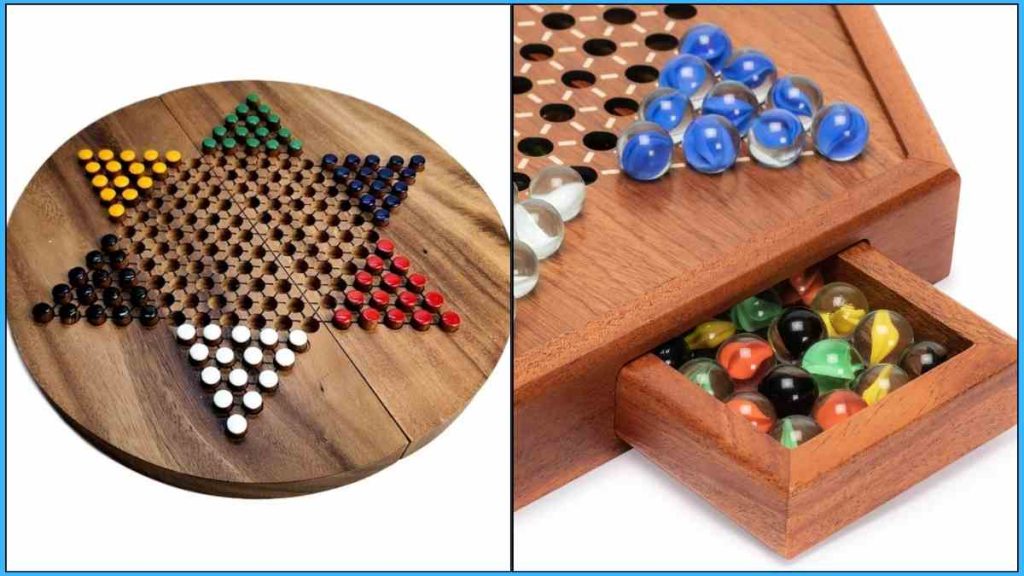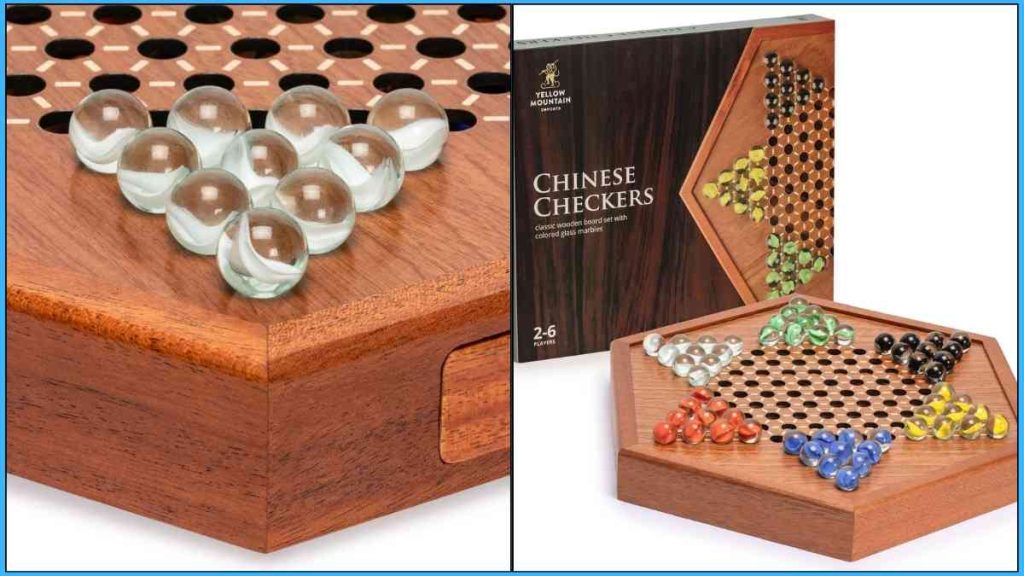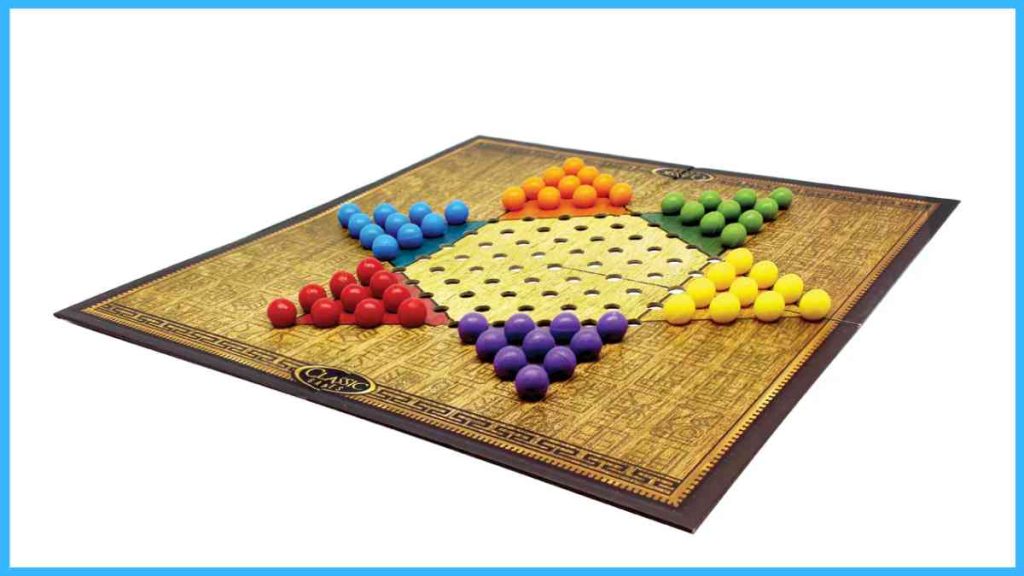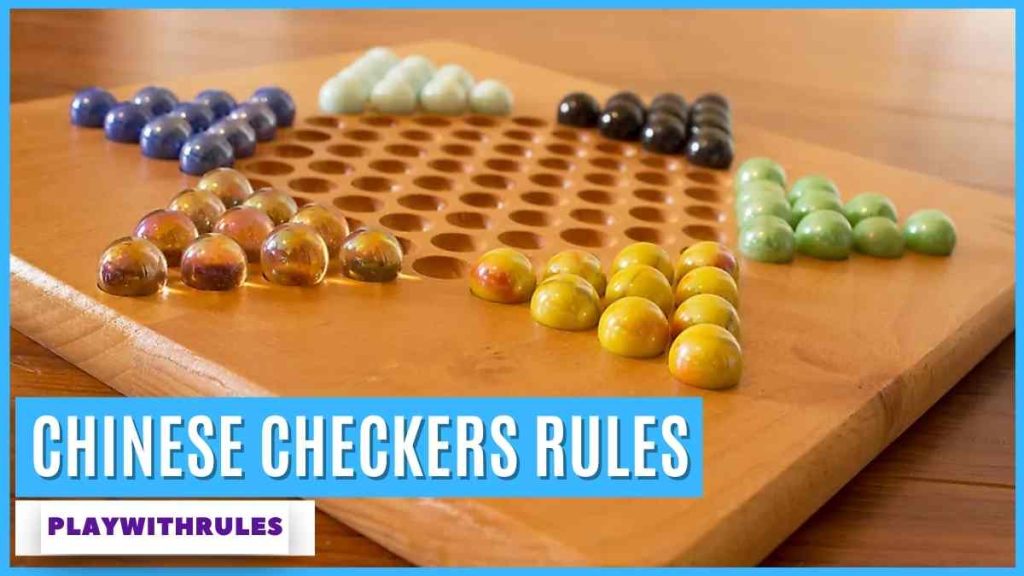Chinese Checkers Rules: Games that require strategizing and using your wits are incredibly fun to play. One game of pure strategy that is supremely intense and challenging is Chinese Checkers, and today, we will be learning the rules of Chinese Checkers.
Players race with each other to create triangles using colored pegs on the other end of the Chinese Checkers board. However, you are constantly competing with other players to try to do the same, which means every move you make needs to be tactical. Ready to conquer the Chinese Checkers board? Let’s get into it!
Table of Contents
How To Play Chinese Checkers?
The game is played on a Chinese Checkers board with holes in it. Each player has a starting triangle and 10 marbles that constitute that triangle. Throughout the game, players employ strategies and math to transfer all their marbles or pegs to their destination triangle before the other players do.
Players can hop and skip pegs to move to the next adjacent spot on the board. However, specific regulations or guidelines dictate legal moves when moving across the board. These rules for Chinese Checkers must be followed.
Objective
Every player starts at a particular triangle on the board. This triangle constitutes 10 pegs/marbles of the color of the player’s choosing. Then, once the game begins, players are to move their pegs/marbles to the triangle directly opposite the starting triangle on the board. This is their destination triangle. The objective is to have all their marbles in their destination triangle before the other players. Simple, right? But you need to follow a strategy to do so.
Setup & Players
You need the Chinese Checkers board and different colored pegs to play Chinese Checkers. The board resembles a star with 6 points, making 6 triangles across the playing board. The entire playing area is filled with spots or holes where players can place their marbles/pegs. Every side of the hexagon (the playing area) has 5 holes.
The game can be played between 2-6 players. Each case has a pattern for choosing your side of the board. The pattern is as follows:
- 2 Players – Choose any pair of opposing triangles on the board.
- 3 Players – Choose every other triangle on the board, i.e., every alternate triangle.
- 4 Players – Choose 2 pairs of opposing triangles on the board.
- 6 Players – Play with all the triangles on the board.
According to the rules for Chinese Checkers, the game cannot be played between five players because there is no fair way of playing it. Each player chooses a color of peg or marble to play with. Each player is given 10 such pegs/marbles to place in their home triangle on their side of the board.

Chinese Checkers Rules
The ‘How To Play Chinese Checkers’ is quite simple. There are clear guidelines for players moving their pegs across the board to get to the destination triangle. Each player gets a single turn, and then the play proceeds clockwise. Ready to learn the Chinese Checkers Rules? Let’s dive in!
- Every player can move only one peg of their choosing on their turn. After their turn, the play shifts to the next player (clockwise), and so on.
- A peg can move into an adjacent hole if it’s open or unoccupied. Pegs cannot be replaced, irrespective of whether the peg is an opponent’s or your own.
- A jump move is also allowed if an empty space on the other side of a peg is in your way. Let’s say there is a peg in front of you (your opponent’s or your own). Then, you can hop over the obstructing peg and place your peg in the next hole as long as the space is empty.
- According to Chinese Checkers jumping rules, Pegs cannot jump two empty holes in a row. Also, pegs cannot jump over two adjacent pegs.
- A peg can move in any direction as long as it moves in a straight line.
- Per Chinese Checkers jumping rules, a player can jump any number of subsequent hops in a single turn if they want. However, each jump needs to be in a straight line, and it cannot be over more than one obstructing peg in a line. That being said, you do not have to complete all the jumps if you don’t want to.
- If your peg reaches your destination triangle (the opposite triangle), then you cannot move that peg out of the triangle. However, you can move the peg around inside the triangle and change its position.
- A player cannot place their peg into an opponent’s triangle who is not sitting directly opposite them. But you can move your peg through their triangle (as many legal jumps or hops as you want) as long as you end up outside their triangle.
- If one peg of an opponent player is blocking your slot (provided all other slots on their triangle have been filled with your pegs), you can swap their peg for yours and win it. Alternatively, if the opponent has only one peg in their triangle and you have placed all 9 of your pegs in their triangle (9 pegs in the destination triangle), then you win by default, per the rules of Chinese Checkers.
- The rules for Chinese Checkers also state that pegs cannot be removed from the board during the game.
Anti-Spoiling
Spoiling or blocking is the move where a player’s peg blocks an opponent from placing all their pegs in their triangle. This is essentially blocking a player from winning. There are differing schools of thought on whether Spoiling or Blocking should be allowed as part of the rules of Chinese Checkers.
In many cases, blocking the opponent from winning is considered a legal/fair move. However, several anti-spoiling rules have been proposed. For example, if an opponent’s peg is blocking you from placing your last peg in the destination triangle and winning, you can swap that peg and put your own. This applies to both single-hole moves or a part of any jumping move.
Partnerships And Multiplayer Modes
Partnership games are always fun. In this mode, partners sit opposite each other and try to put their pegs in their partner’s star point. There are two ways to play in a partnership mode, and Chinese Checkers Rules in a partnership game are as follows:
- The first player to get all their pegs inside their partner’s star point wins the game for their team.
- Both partners must get all their pegs inside their partner’s star point to win the game. In such a case, if one player in the partnership has all their pegs in the destination star, they can utilize their turn to help their partner move their pegs into their destination star.
If you want to go up the ante and have more fun, try Multiplayer Mode. Let’s assume 6 players are playing. Then, the game can be played as ‘free for all,’ where every player plays for themselves, or you can team up. Three teams of two players each are created, and each player is set up at the opposite triangle from their teammates.

Variations
Chinese Checkers is a widely popular game, and the thing with popular games is that there is always a variation or two of that game that you can try. In this case, we will discuss four variations of Chinese Checkers. They are as follows:
Super Chinese Checkers
Super Chinese Checkers are like Chinese Checkers with superpowers. In this game version, players can jump over a peg any number of holes away, provided they can land the peg, an equal number of holes away, on the other side of the middle peg (the peg jumped over) in a straight line. This speeds up the game and makes it far more interesting. However, players need to stick to the rules for Chinese Checkers while playing this version.
Multiple Triangle Game
The Multiple Triangle Game is another fun take on a standard game of Chinese Checkers when the total number of players is 3. In this case, each player can take up two triangles each (6 triangles total) and play with both.
Online/Mobile Chinese Checkers
A lot of websites offer digital versions of the game. This removes the need to buy a Chinese Checker board and the pegs to play the game. All you need to do is download an app or play online. Certain games even offer multiplayer modes where you can either team up or play against an opponent online.
Scoring Method (Longer Gameplay)
The scoring method drags the game out a bit longer, so if you want the game to go on for longer and be more intense, then the scoring method is a variation that you will thoroughly enjoy. According to this method, the winner is awarded 10 points at the end of a round. The other players are awarded 1 point for each marble successfully placed in their destination star or triangle. According to the rules of Chinese Checkers, a stipulated number of rounds are played, after which the total scores are tallied. The player with the highest score wins the game.

How To Win Chinese Checkers?
The first player to move all 10 of their pegs/marbles from their starting triangle into their opponent’s triangle (destination triangle) wins the game. However, if you are playing a variation of the game where scores are accounted for, as per the rules of Chinese Checkers, the player with the highest score at the end of the stipulated rounds is the winner.
Tips & Strategies
You can do so much with your ten pegs in Chinese Checkers. In fact, everyone can have their own winning strategy, which comes with playing the game often. Here are some valuable tips and techniques to give you a headstart:
- Build a bridge using your pegs or your teammates. A linear bridge to your destination triangle will allow you to skip pegs and move to your destination faster.
- Aim to control the central part of the board. Once you have control of the center of the board, you have a lot more options for skipping or jumping in any direction you want.
- Chain jumps together to make progress faster. This allows you to move ahead quickly and makes it difficult for your opponent to progress using your pegs.
- Once you have secured the lead, you can start mirroring all of your opponent’s moves. This will keep you in the lead and make it difficult for your opponent to surpass you.
- Move multiple pieces instead of focusing on a single peg. This opens up jumping options for you and doesn’t make you an easy target for the opponent. Using a single peg can sometimes be counter-productive. It allows the opponent to anticipate your moves and plan accordingly.
- Moving forward is not always the best idea. You need to make moves that help you win. This may sometimes mean moving your peg backward or sideward to open up jumping options.
Did You Know?
- Although the game is called Chinese Checkers, it wasn’t actually invented in China. It was invented in 1892 in Germany. It was originally called “Sternhalma.” Later, the game was rebranded as Chinese Checkers in the United States.
- The game became incredibly popular worldwide in the early 20th century, especially in Japan, where it is called the ‘Diamond Game.’
- Chinese Checkers has always been fascinating, especially for mathematical combinatorial game theory.
- ‘Jump Chess,’ ‘Hop Across,’ and ‘Hop Ching Checkers’ are just some of the different names the game is referred to in other regions worldwide.
FAQs
How many players can play Chinese Checkers?
The game can be played between 2 and 6 players. However, 5 players cannot play it as it makes it impossible to play fairly.
What are some of the best strategies to win Chinese Checkers?
There are so many different strategies that you can employ at various points during the game. Two well-proven tactics that work are taking control of the board centre and creating long bridges to facilitate long jumps across the board.
Can you move backwards in Chinese Checkers?
Yes, you can move your pegs backwards or in any direction in Chinese Checkers as long as the movement is in a straight line.
Can you jump over your own marbles in Chinese Checkers?
According to the rules of Chinese Checkers, you can jump over your own and your opponent’s marbles in the game. However, you cannot jump over more than 2 marbles in a row.
If you want to win at Chinese Checkers, you must be tactical and strategic with every move you make while following the Chinese Checkers Rules. Chinese Checkers is all about analyzing opponents’ potential moves and devising your strategy to beat them. You can team up with a friend, or if you prefer riding solo, you can do that as well, but remember to always ‘Play With Rules.’ Good luck!
READ MORE:- Sequence Rules: How To Play, Setup, Winning

